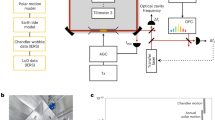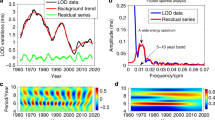Abstract
THE standard instrument for declination measurements at the Magnetic Observatory, Hermanus, is an Askania standard magnetometer-theodolite of the Schmidt type. The two declination magnets supplied with the instrument are in the form of solid steel cylinders of length 7 cm. and diameter 1.2 cm., fitted with plane mirrors at both ends. The telescope is of the usual ‘auto-collimating’ type. Provided the angle between the magnetic axis and the normal to a particular mirror surface remains constant, the difference between the ‘magnet erect’ and ‘magnet inverted’ readings (E–I) provides a ready control during observations.
This is a preview of subscription content, access via your institution
Access options
Subscribe to this journal
Receive 51 print issues and online access
$199.00 per year
only $3.90 per issue
Buy this article
- Purchase on Springer Link
- Instant access to full article PDF
Prices may be subject to local taxes which are calculated during checkout
Similar content being viewed by others
Author information
Authors and Affiliations
Rights and permissions
About this article
Cite this article
VAN WIJK, A. Observed Changes in the Angle between the Magnetic Axis and the Geometric Axis of a Bar Magnet. Nature 165, 726–727 (1950). https://doi.org/10.1038/165726b0
Issue Date:
DOI: https://doi.org/10.1038/165726b0
Comments
By submitting a comment you agree to abide by our Terms and Community Guidelines. If you find something abusive or that does not comply with our terms or guidelines please flag it as inappropriate.



